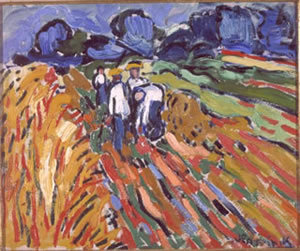Maurice de Vlaminck
dal 19/2/2008 al 19/7/2008
Segnalato da
19/2/2008
Maurice de Vlaminck
Musee du Luxembourg, Paris
A fauvist instinct. This exhibition brings together works of the period 1900-1915, from the artist's earliest known paintings, in which he already asserted his characteristic violence, down to the works produced at the beginning of the First World War, which reflect his contemporary research on the rendering of space. An overview of his production at that time reveals the key part he played in the renewal of painting, and the inventiveness of the research he undertook with Derain and which made Chatou one of the most active centres of that renewal.

This exhibition brings together works of the period 1900-1915, from Maurice de Vlaminck’s (1876-1958) earliest known paintings - Vlaminck’s career started when he was 17, but none of his juvenalia has been preserved - in which he already asserted his characteristic violence, down to the works produced at the beginning of the First World War, which reflect his contemporary research on the rendering of space.
An overview of Vlaminck’s production at that time reveals the key part he played in the renewal of painting which started in the early 20th century, the inventiveness of the research he undertook with Derain and which made Chatou one of the most active centres of that renewal.
Vlaminck’s work, during that time of important questioning and aesthetic transformations, ought to be considered both through its relation with the post-impressionistic generation that had preceded him (Van Gogh, Gauguin, the Nabis, Cézanne, Signac) and for his tremendous audacity which allowed for all sorts of excess in expressive gesture, colour paroxysm and selective deformation: “I heightened all the tones, I tranposed all the feelings I could perceive into my orchestration of pure colours. I was a tender, wild at heart barbarian” (Dangerous Corner, 1929).
Musee du Luxembourg
19 rue de Vaugirard - Paris



